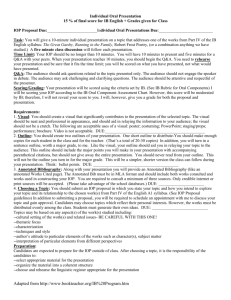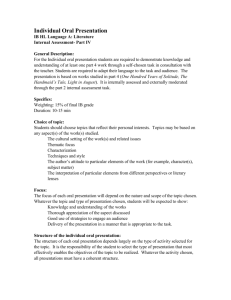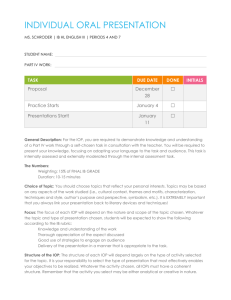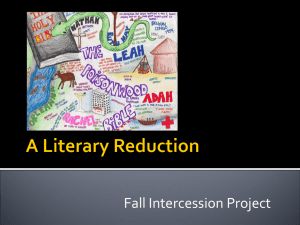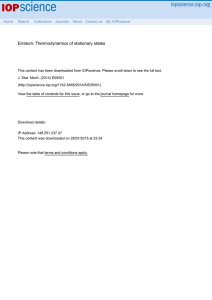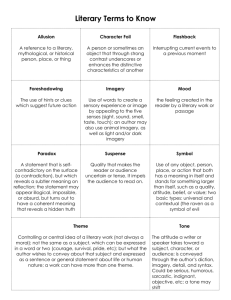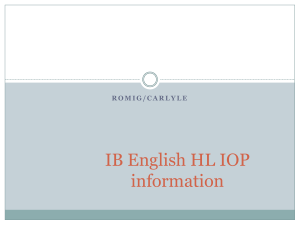Individual Oral Presentation – guidelines
advertisement
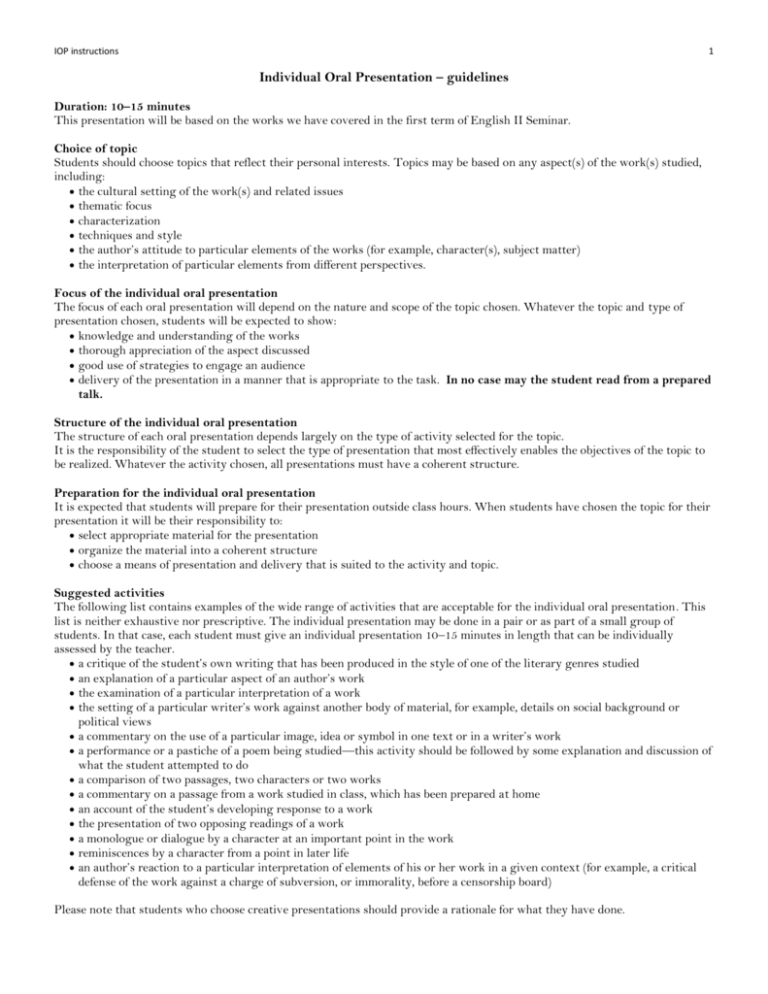
IOP instructions 1 Individual Oral Presentation – guidelines Duration: 10–15 minutes This presentation will be based on the works we have covered in the first term of English II Seminar. Choice of topic Students should choose topics that reflect their personal interests. Topics may be based on any aspect(s) of the work(s) studied, including: the cultural setting of the work(s) and related issues thematic focus characterization techniques and style the author’s attitude to particular elements of the works (for example, character(s), subject matter) the interpretation of particular elements from different perspectives. Focus of the individual oral presentation The focus of each oral presentation will depend on the nature and scope of the topic chosen. Whatever the topic and type of presentation chosen, students will be expected to show: knowledge and understanding of the works thorough appreciation of the aspect discussed good use of strategies to engage an audience delivery of the presentation in a manner that is appropriate to the task. In no case may the student read from a prepared talk. Structure of the individual oral presentation The structure of each oral presentation depends largely on the type of activity selected for the topic. It is the responsibility of the student to select the type of presentation that most effectively enables the objectives of the topic to be realized. Whatever the activity chosen, all presentations must have a coherent structure. Preparation for the individual oral presentation It is expected that students will prepare for their presentation outside class hours. When students have chosen the topic for their presentation it will be their responsibility to: select appropriate material for the presentation organize the material into a coherent structure choose a means of presentation and delivery that is suited to the activity and topic. Suggested activities The following list contains examples of the wide range of activities that are acceptable for the individual oral presentation. This list is neither exhaustive nor prescriptive. The individual presentation may be done in a pair or as part of a small group of students. In that case, each student must give an individual presentation 10–15 minutes in length that can be individually assessed by the teacher. a critique of the student’s own writing that has been produced in the style of one of the literary genres studied an explanation of a particular aspect of an author’s work the examination of a particular interpretation of a work the setting of a particular writer’s work against another body of material, for example, details on social background or political views a commentary on the use of a particular image, idea or symbol in one text or in a writer’s work a performance or a pastiche of a poem being studied—this activity should be followed by some explanation and discussion of what the student attempted to do a comparison of two passages, two characters or two works a commentary on a passage from a work studied in class, which has been prepared at home an account of the student’s developing response to a work the presentation of two opposing readings of a work a monologue or dialogue by a character at an important point in the work reminiscences by a character from a point in later life an author’s reaction to a particular interpretation of elements of his or her work in a given context (for example, a critical defense of the work against a charge of subversion, or immorality, before a censorship board) Please note that students who choose creative presentations should provide a rationale for what they have done. IOP instructions 2 Conduct of the presentation and subsequent discussion Teachers must allow students to do their presentation without any interruption or assistance. When the presentation is completed teachers may engage in a discussion with students in order to probe further into their knowledge and understanding of the work(s) or topic. Teachers should be satisfied that students have justified their selection of: the material used in the presentation the activity chosen to convey the topic the suitability of the style of presentation. The whole class may participate in the subsequent discussion. The student is, however, only assessed on the presentation (which includes the rationale where appropriate). Student’s role choosing the topic for the IOP, in consultation with the teacher selecting the work(s) through which the topic will be explored choosing the type of presentation which is most appropriate for meeting the objectives of the topic selecting and organizing the material to be presented into a structure appropriate to the objectives of the presentation deciding on the linguistic register appropriate for the presentation rehearsing the presentation Teacher’s role holding consultation sessions with students to agree on appropriate topics and styles of presentation that can be properly evaluated by the assessment criteria for the oral component ensuring the availability of all logistical needs for each student’s presentation conducting the IOP for each student and leading the subsequent discussion ensuring that each student’s presentation lasts for 10-15 minutes using the appropriate assessment criteria to evaluate each student’s IOP Essentials Students must be able to show their knowledge and understanding of the work(s) used for the presentation. Students must choose a manner of presentation that matches the chosen style of delivery and use strategies to make the presentation interesting for the audience. The choice of language must be suited to the type of activity and style of delivery. It could be an informal register if the student is attempting to convey the voice of a character in a role play, or it could be a formal register if they choose to present an analysis. Discussion must follow the presentation, so it is best conducted as a class activity or an activity done in front of an audience. Points to keep in mind Where students work together to deliver a presentation the teacher must apply the assessment criteria separately to each student. If students choose to use role play they need to include a rationale that explains what they are trying to achieve with the performance. If students use visual aids such as a PowerPoint® presentation, they should not read from a large number of slides. This would be similar to reading from a prepared talk and unlikely to engage the audience. Students should select their own topic and plan their presentation alone, albeit with the teacher’s guidance. Presentation topics should not be repeated between students. Students have only one attempt, which should be treated as an examination. The time limit for the task is 10–15 minutes, including questions, and ideally some brief discussion as a class. IOP instructions 3 Tips for Preparing for the IOP (Basel, Charmaine. <www.occ.org>) Decide on your material. Pick the literature and focus you are interested in discussing or exploring. It will make the rest much easier. Select a topic that is tightly focused. For example not just “Race and Gender” in the novels studied but “How racial hierarchy is set up in the novels and the way it impacts on gender.” Rather than “Power Relations” you could say “How different characters’ power is presented through the use of language.” Or – instead of “Death and its consequences” – “The way in which death impacts on other characters in…” (Whatever the choice may be) Select the most appropriate extracts to demonstrate your points of view. The extracts you choose should be the most appropriate to highlight the points you want to make. Make sure that you focus on every literary technique contained and explain their effect. Include syntax and diction, as well as the more obvious literary techniques used in prose. Refer to the text. Include examples and well-incorporated quotations. Make sure that you fulfill the criteria listed on the Assessment Sheet Look at what marks are awarded for and make sure that you fulfill all of the criteria. Rehearse– again and again – and TIME IT. You should sound confident, self assured. Face the audience. Make sure to make eye contact - throughout. Notes should only be lightly referred to not read the whole way through. You should sound interested in your own speech – vary tone and gesture. Power point presentations should be there to refer to not to rely on. You must fulfill time requirements or you will be penalized. You will be asked questions at the end of your presentation. Make sure that you come up with a list of possible questions you might be asked and think about the answers. Make sure you understand how the extract fits into your understanding of the rest of the novel. PREPARE. Prepare in advance all the materials you will need for presentation day. It will reduce your stress level immensely. 1-2 3-4 5-6 7-8 9-10 Criterion A: Knowledge and understanding of the work(s) How much knowledge and understanding does the student show of the work(s) used in the presentation? does not reach standard 0 There is little knowledge or understanding of the content of the work(s) presented. There is some knowledge and superficial understanding of the content of the work(s) presented. does not reach standard Delivery of the presentation is seldom appropriate, with little attempt to interest the audience. Delivery of the presentation is sometimes appropriate, with some attempt to interest the audience. There is very good knowledge and understanding of the content and most of the implications of the work(s) presented. Delivery of the presentation is effective, with suitable strategies used to interest the audience. There is excellent knowledge and understanding of the content and the implications of the work(s) presented. Criterion B: Presentation How much attention has been given to making the delivery effective and appropriate to the presentation? To what extent are strategies used to interest the audience (for example, audibility, eye contact, gesture, effective use of supporting material)? Criterion C: Language How clear and appropriate is the language? How well is the register and style suited to the choice of presentation? (“Register” refers, in this context, to the student’s use of elements such as vocabulary, tone, sentence structure and terminology appropriate to the presentation.) There is adequate knowledge and understanding of the content and some of the implications of the work(s) presented. Delivery of the presentation is appropriate, with a clear intention to interest the audience. does not reach standard The language is rarely appropriate, with a very limited attempt to suit register and style to the choice of presentation. The language is sometimes appropriate, with some attempt to suit register and style to the choice of presentation. The language is mostly clear and appropriate, with some attention paid to register and style that is suited to the choice of presentation. The language is clear and appropriate, with register and style consistently suited to the choice of presentation. The language is very clear and entirely appropriate, with register and style consistently effective and suited to the choice of presentation. Delivery of the presentation is highly effective, with purposeful strategies used to interest the audience. IOP instructions 4 Understanding the IB Rubric Criterion Language very clear, effective, carefully chosen and precise high degree of accuracy in grammar, vocabulary and sentence construction effective and appropriate register and style Organization effectively organized and developed reader is engaged and persuaded requires the coherence of ideas within should incorporate quotations into their writing in such a way that the development of their ideas is enhanced and not impeded, should avoid using large blocks of quotations consistent with required formatting Presentation reader is engaged and persuaded require careful structuring a clear, sustained focus and purposeful development of ideas (with links between elements) Knowledge and understanding of literary works is the expression of an author’s individual creativity and as representatives of their genre and period. Knowledge refers to familiarity with the work. Understanding is the ability to interpret the writer’s intention and to understand how context may affect that interpretation—both the context of the work and what the reader brings to the reading. know the main features of the genre the text exemplifies demonstrate the ability to evaluate the effectiveness of the use of the various conventions. discuss the links between works: differences and similarities in their context, style, structure, theme and so on understand cultural values as expressed in literature, and the significance of context in literary works. The actions of the characters in a literary work should not be judged by the student’s own time and culture. statements or assertions must be validated and have evidence to support them carefully chosen, detailed references to the work(s), passage or extract demonstrate their independent interpretation and depth of understanding evidence provided in the form of quotations and line references should set quotations in context, integrated into the text of the essay and accompanied by explanation or analysis Analysis of literary techniques demonstrate an ability to analyze language, structure, technique and style know the difference between description and analysis Evaluation recognize how and why literature affects the reader see how, in literary terms, one writer compares with another. Similar literary techniques will affect readers differently and students are expected to be able to analyze, discuss and justify their own response to the choices that writers make. Independent literary criticism acquire for themselves the skill of reading between the lines see how writers have achieved their effects and how they may be trying to persuade the reader to accept their views of the subject of the prose passage or poem build on what they have learned in class, but also show that they have thought for themselves about the topic IOP instructions 5 IOP Topic Proposal Form (page 1 of 2) Name: ___________________________________________ Type of Presentation (circle one): Creative Section: ____________ Analytical Work(s) studied: Aspect(s) on which you intend to focus: Rationale for selection of work(s) and aspect: How you intend to explore these aspects: (Creative IOPs ONLY) Sentences, concepts, sections, structure, etc from the work that you address or imitate: IOP instructions 6 IOP Topic Proposal Form (page 2 of 2) Title of Presentation: _____________________________________________________________________________________ Nature of presentation (what do you intend to do; include considerations of audience, register, and format): Materials needed for the presentation: Thesis Statement: ________________________________________________________________________________________ _________________________________________________________________________________________________________ _________________________________________________________________________________________________________ _________________________________________________________________________________________________________ _________________________________________________________________________________________________________
